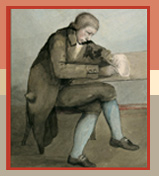
Iolo's People
Edward 'Celtic' Davies (1751-1831)
Evan Davies (Myfyr Morganwg, 1801-88)
Walter Davies (Gwallter Mechain, 1761–1849)
T C Evans (Cadrawd, 1846-1914)
Owen Jones (Owain Myfyr, 1741–1814)
Sir John Morris Jones (1864-1929)
William Owen Pughe (1759-1835)
William John Roberts (Gwilym Cowlyd, 1828-1904)
David Samwell (Dafydd Ddu Feddyg, 1751–98)
David Thomas (Dafydd Ddu Eryri, 1759–1822)
Griffith John Williams (1892-1963)
John Williams (Ab Ithel, 1811-62)
The London-Welsh Societies
From his early days, Iolo was a great enthusiast of the London-Welsh societies, which combined conviviality with a healthy patriotic zeal for Welsh letters and antiquarianism. His long partnership with these societies had far-reaching repercussions on his bardic vision, for they not only stimulated his ardent sense of Welsh patriotism but also influenced bardism's powerful regional dimension. Initially their focus on Gwynedd exerted a positive influence on him and inspired him to take pride in the literary fortunes of Glamorgan. For example, he tried to establish a similar society in Glamorgan called 'Brodoliaeth Beirdd Morganwg' (The Fraternity of Glamorgan Poets).
The Honourable Society of Cymmrodorion
The bilingual constitution of the Cymmrodorion, published in 1751, outlined specific aims for the cultivation of the Welsh language and research into its antiquities. It was also an expression of the patriotic impulse of the eighteenth-century cultural revival:
There is implanted in the Nature of Mankind, a strong Attachment to that Country which gave them Birth, and a laudable Curiosity to acquaint themselves with the genuine History and Antiquities of those People from whom they are immediately descended . . . To this End, a considerable Number of Persons, Natives of the Principality of Wales, now residing in and about London, inspired with the Love of their common Country, and consulting the Honour of the British Name, propose to establish a general Monthly Society, distinguished by the Name and Title of Cymmrodorion (or Aborigines). (Gosodedigaethau Anrhydeddus Gymdeithas y Cymmrodorion (Llundain, 1755), pp. 5, 11.)
The society was established in 1751 by Richard Morris, younger brother of Lewis Morris, with the aim of providing a social focal point for the Welsh in London. The society supported many ventures (including Thomas Richards's dictionary) but failed to realize the ambitious aims set out by Lewis Morris in its constitution. The society petered out in 1787, but was revived in 1820 by a new wave of cultural patriots bent on promoting the newly-established provincial eisteddfodau.
The Gwyneddigion Society
The Gwyneddigion Society was established in 1770 by London Welshmen who reckoned that the Cymmrodorion was too snobbish and dilatory. Ostensibly a debating and cultural society for those who spoke Welsh fluently, it encouraged members to correspond with each other and with others on cultural and antiquarian matters. The society carried the cultural mantle of the Cymmrodorion but, thanks to the generous financial support of Owen Jones, the Gwyneddigion achieved much more than its predecessor. Among the publications instigated and financed by the Gwyneddigion were Barddoniaeth Dafydd ab Gwilym (1789), The Myvyrian Archaiology of Wales (1801-7) and the short-lived magazine Y Greal (1805-7). From 1789 onwards the Gwyneddigion were actively involved in promoting what became the eisteddfod movement, and patronized successful eisteddfodau at Bala (1793) and Caerwys (1798).
The Caradogion Society
The Caradogion Society, an offshoot of the Gwyneddigion Society, was established during the 1790s. The Society met at the Bull's Head tavern ('Y Crindy') in Walbrook and catered for Welsh speakers and non-Welsh speakers alike, and held weekly debates. The turbulent political climate meant that several members were suspected of sedition and were persecuted by the authorities.

